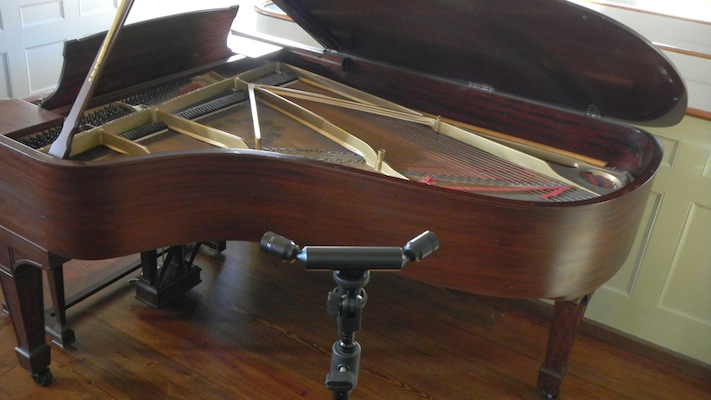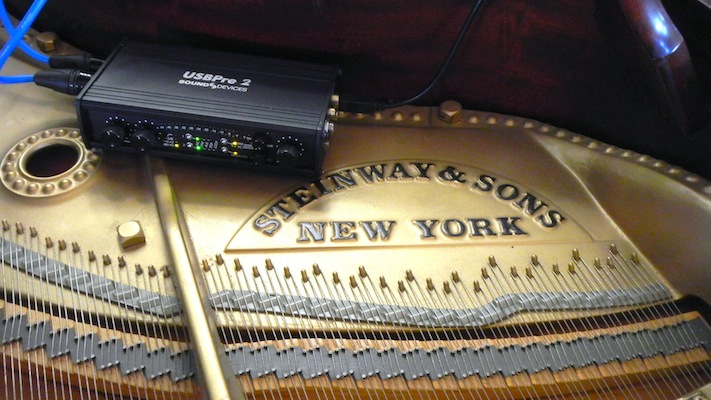
Month: December 2017
Superlux S502 ORTF Microphone Array
 Photo © John Marks
Photo © John Marks
In my recent post about my using Sound Devices’ USBPre 2 as a location-live recording interface, I mentioned the “near-coincident” ORTF stereo microphone technique. In that case, I used an AEA stereo mic protractor ($22) to position two Pearl (Sweden) CC22 cardioid-pattern side-address microphones in the so-called ORTF array. The ORTF array is a compromise between crossed-axis “coincident” X/Y cardioid or figure-8 microphones, and “A-B” widely-spaced omnidirectional microphones. The idea is to mimic the response of the human head/ear/brain system concerning horizontal-plane stereo cues, while preserving good compatibilty to monophonic mix-down, by which I mean the avoidance of self-cancellation. Continue Reading →
Joseph Silverstein: Edward Elgar, Violin Concerto (conclusion); Boston Symphony, Colin Davis
From the Boston Symphony’s YouTube channel, here is the conclusion of the October 24, 1972 performance by Joseph Silverstein (who was then the Concertmaster of the Boston Symphony), of Edward Elgar’s Op. 61 violin concerto in B minor. The guest conductor is Colin Davis (who was knighted eight years later). By the way, at 1 minute 26 seconds, I believe I hear Colin Davis humming (or groaning) along, to bring out the big tune. (In Elgar, there’s usually a big tune.) The video runs from slightly before the (accompanied) cadenza through the end of the third, final movement.
Elgar’s violin concerto is one of the longest and most demanding violin concertos in the standard repertory. Its running time (modern recordings average circa 50 minutes) is about twice that of the most popular violin concertos (those of Mendelssohn and Tchaikovsky). In addition to the demands Elgar’s concerto makes on the soloist’s endurance, his concerto presents many technical challenges. And portions of this video give an excellent birds-eye view of Silverstein’s rising to meet those violinistic demands.
Although Elgar’s rhapsodic style here, which is both discursive and intensely emotional, might take a bit of getting used to, I find that through the years, Elgar’s has always been one of my favorite violin concertos. And, as you will see as you read on past the jump link, I agree with my friend Bob Ludwig: that with Elgar, the interpretation makes the performance—this is not music that “plays itself.” Continue Reading →
Sound Devices USBPre 2 as a Location-Live Recording Interface

As part of my series on making digital transfers of vinyl LP phono records, I recommended Sound Devices’ USBPre 2 (street price $895) as the most cost-effective (“Pareto Optimal”) USB combination analog-to-digital converter and monitor (headphones or loudspeakers) controller. In that usage, the USBPre 2 takes an analog output from a phono stage through its line-level RCA jacks and converts the analog signal to digital (at data densities up to 24 bits/192kHz), and outputs the digital datastream via USB cable to a host computer (which is also the source of the USBPre 2’s power). The linked-to blog post enumerates the USBPre 2’s many virtues, and makes a compelling case for its value for money.
In addition to digitizing LPs, the USBPre 2 can be used for live recording. The USBPre 2 can provide 48V “phantom” power to professional microphones (but the 48V power can be switched off for pure-ribbon or dynamic microphones). Further, the USBPre 2’s metering and monitoring are truly professional-class. Given that the USBPre 2’s microphone preamplifiers are based on those of Sound Devices’ industry-standard 700 Series remote-location portable digital recorders, I wanted to make a location-live solo-piano recording. More details, and a sound sample, after the jump. Continue Reading →
In Memory of Richard Shahinian, 1931 – 2017
In memory of music lover and loudspeaker designer Richard “Dick” Shahinian, I offer a very impressive live performance of Mozart’s Requiem, by the French vocal ensemble Arsys Bourgogne with the Camerata Salzburg. Aside from faith and family, Dick’s major passion in life was large-scale orchestral music (or large-scale works for orchestra and chorus). The larger the scale, the better, it seemed. During one audio show, I asked Dick to play on his demo system a track I had brought with me, a live recording of Jessye Norman singing the Angel’s Farewell from Elgar’s The Dream of Gerontius. After the track had played, Dick allowed that it was all fine and good; but then he asked me why had I not played the Demons’ Chorus, instead? That’s Dick in a nutshell—unusually knowledgeable about even the most obscure musical works, and… very opinionated.
Dick’s love affair with classical music began at age 14, with the birthday present of a 78-rpm phonograph and a recording of Gershwin’s Rhapsody in Blue. About a year later (1946), at Carnegie Hall, Dick heard the New York Philharmonic play Richard Strauss’ Metamorphosen and Bruckner’s Eighth Symphony, conducted by Bruno Walter. Years later, Dick wrote, “I have never quite recovered from the shattering impact of that experience.”
After serving honorably in the United States Marine Corps, from the late 1950s on (the blossoming of the Golden Age of Hi-Fi), Dick devoted his career to bringing the thrill of live orchestral music into peoples’ homes (to the greatest extent possible, that is) by advancing the art of loudspeaker design. For more, please click on the jump link. Continue Reading →


